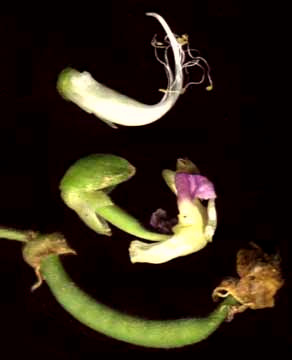
The picture at the right is taken from above the flower, so the top petal is the standard, as explained on our Bean Flower page. The two petals projecting toward the right of the picture -- the flower's side petals -- are the two wings. The big surprising feature of this flower is the what seems to be the white, roundish thing in the picture's center, between the wings. That's the flower's keel, which curls up and bends back into the flower's throat! This "coiled keel" is the distinctive mark of the genus Phaseolus, so all garden-grown green-bean/stringbean/snapbean or shell bean blossoms have it.

At the top of the picture at the left the corolla has been removed so you can see how the filaments join at the base into a cylinder surrounding the pistil. There the white style curves upward among the ten stamens' slender filaments which, by the way, are diadelphous, as defined on our our Bean Flower Page.
The middle image at the left shows a flower in which the anthers' pollen has been shed, the pistil has been pollinated, and now the pistil is enlarging, shoving the corolla away.
At the picture's bottom the corolla now is shriveled, brown, and about to fall away, and the pistil is beginning to look like a green bean. It's about ¾-inch long (2 cm).
Below is a mature green bean 6.5 inches long (17 cm). Notice how part of one side of the bean has been removed to reveal three seeds, or beans. This fruit is a classic legume. On our Simple Dry Fruits Page, legumes have been described technically as developing from "...one-carpel ovaries, but they split along two sides, not one, as in the case of follicles."
